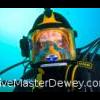Posted 09 October 2010 - 12:55 AM
Two things.
1. I see people are disagreeing with this rather simplistic rule and dismissing it because it doesn't take personal SAC rates into effect. Fair enough. But the danger in this is not that it doesn't take SAC rate into effect, it's that it leaves out the CRUCIAL element in gas planning. And that is, that gas planning isn't about what Diver A's SAC rate is, or Diver B's SAC rate. It's about the COMBINED SAC rate of the divers. Assuming that we are following standard practices of actually having a dive buddy. If you're at 100ft on the Spiegel Grove, and your buddy's LP hose bursts and drains the tank, will YOU have enough gas to get BOTH of you to the surface safely without having to do a rapid ascent, and while still being able to perform a normal safety stop. Once you take people through the real math of what is required to do this, going to 100ft on an AL80 generally seems like a bad idea. I've done it, and would do it again depending on the dive buddy, but I wouldn't do it with a stranger.
2. If you want something basic that works and takes breathing rates into effect, use the half depth / half gas rule of thumb. Determine your max depth for the dive, and check your starting pressure. Endeavor to be at half your max depth, when either of your tanks is at half pressure. And half again of that, when the tanks are at 1/4. For instance. On a dive to 100ft with 3000psi in the tanks, you want to ascend to 50ft when the person with the least pressure is at 1500. And you want to be at 25ft when the person with the least pressure has 750. This way, you can ignore matching cylinders, ignore SAC rate differences, etc. For basic recreational diving, this will get you to the surface safely, with time for a safety stop, and enough gas to inflate on the surface and breath the tanks back to the boat. Assuming all has gone well. If your depth is shallower, you'll get more time at max depth and more time mid-water. If the dive is deep, you won't have a lot of time deep, but you'll get off the bottom with enough reserve to keep both you and your dive buddy safe.

















